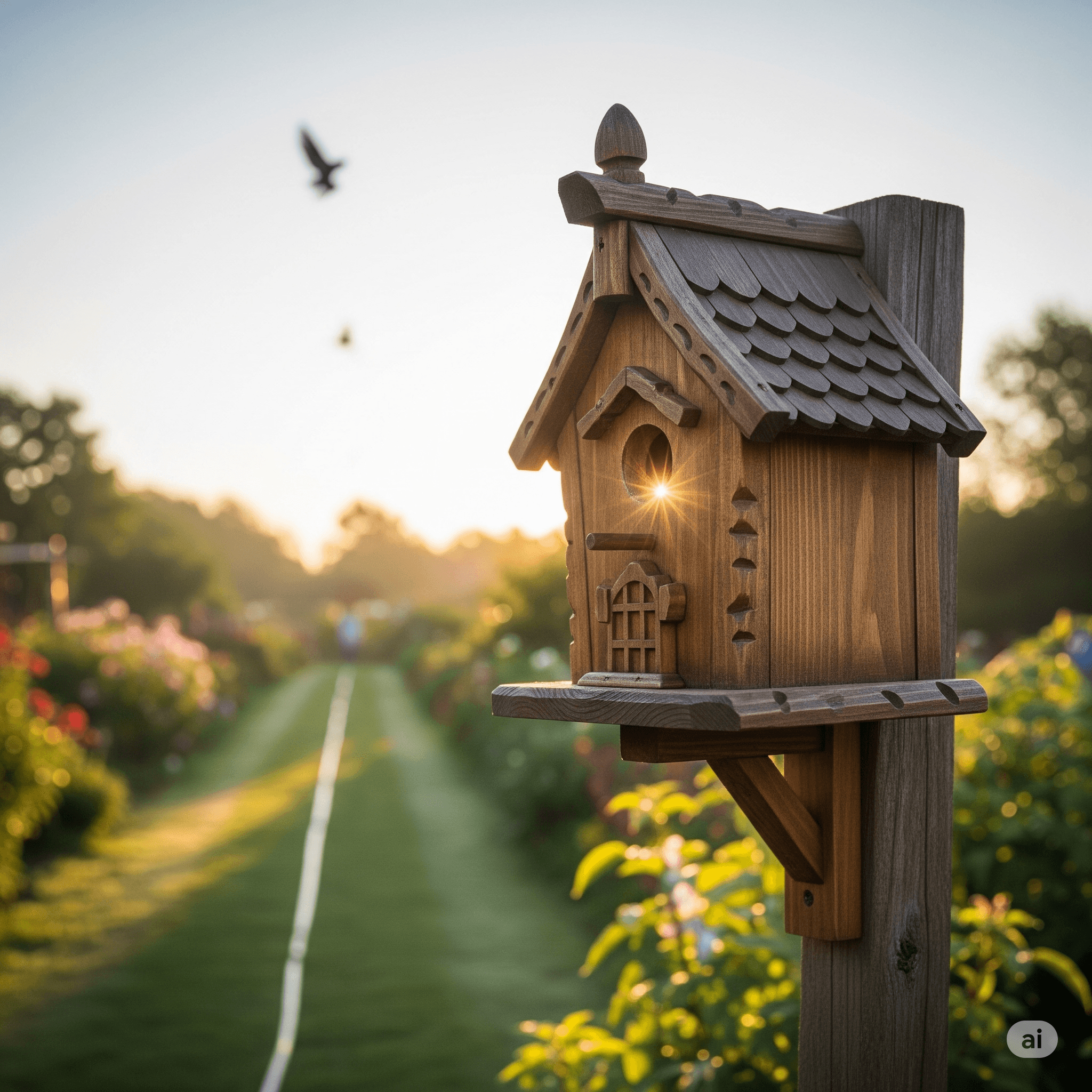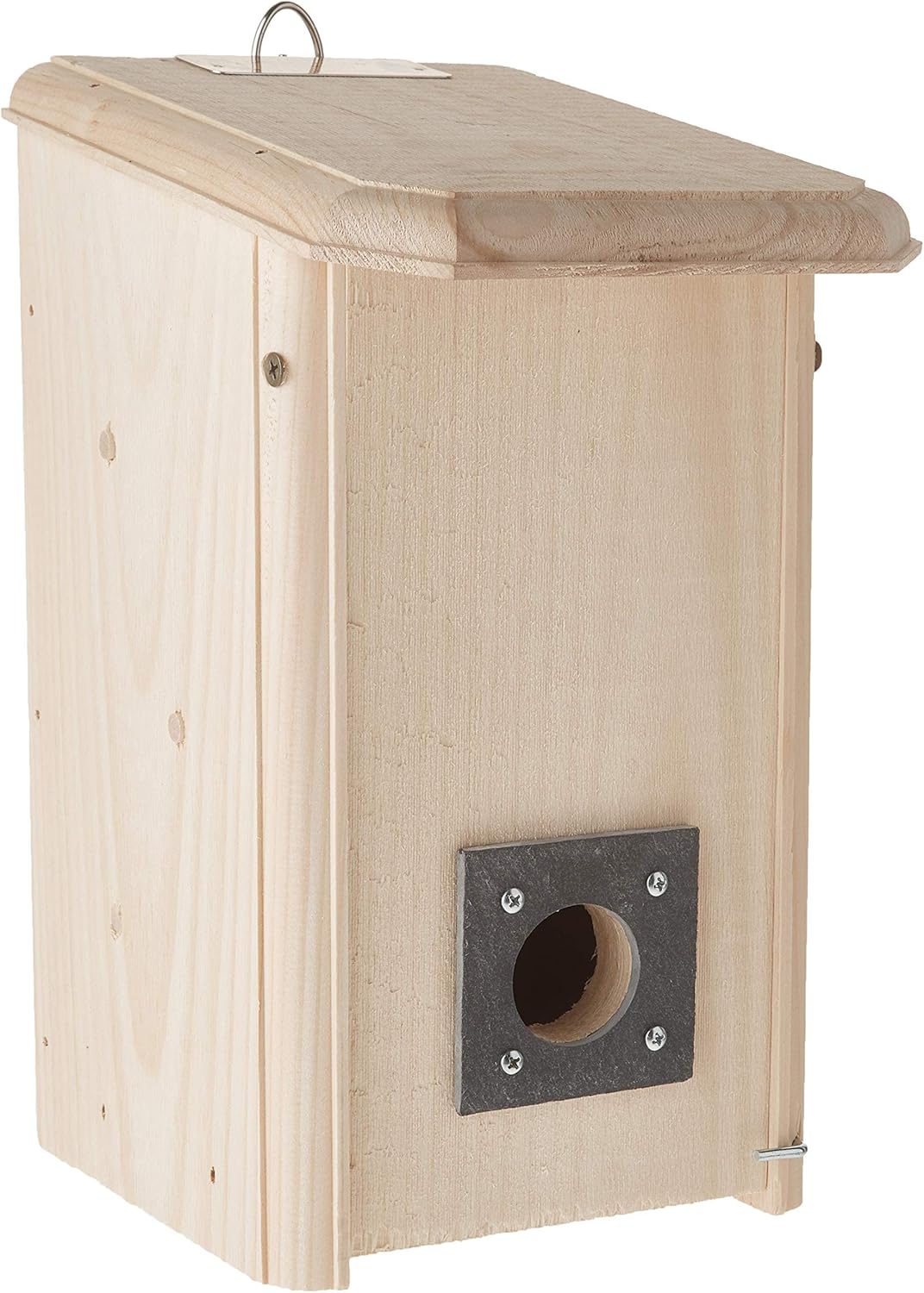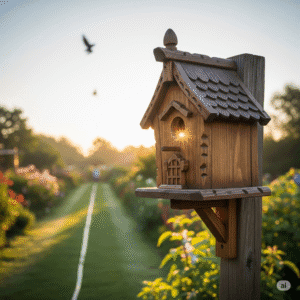What Direction Should a Birdhouse Face? A Guide to Happy Birds

You’ve done it. You’ve picked out the perfect birdhouse, a charming little piece of avian real estate for your backyard. You’re already picturing a pair of cheerful bluebirds or bustling wrens moving in. But before you grab your ladder, there’s a crucial question that can make the difference between a bustling bird family and an empty box: What direction should a birdhouse face?
In my 15 years of backyard birding and habitat creation, I’ve seen firsthand how this single detail can dramatically impact nesting success. The short answer, for most of the United States, is to face the entrance hole toward the east.
This simple orientation provides birds with the gentle morning sun while shielding them from the harsh afternoon heat and prevailing winds. But like any rule in nature, there are nuances and exceptions. This comprehensive guide will walk you through everything you need to know to site your birdhouse perfectly, ensuring it becomes a safe, desirable home for your feathered neighbors.
Quick Siting Checklist
- Primary Direction: Face the entrance hole east.
- Good Alternatives: Southeast or northeast are also excellent choices.
- Direction to Avoid: Never face a birdhouse directly west.
- Key Factors: Protect from prevailing winds, intense afternoon sun, and predators.
- Flight Path: Ensure a clear, open path to the entrance.
The Science Behind the East-Facing Rule: Sun and Shelter
Why is east the magic direction? It’s not just an old birder’s tale; it’s based on fundamental avian needs for thermoregulation and safety. Birds are incredibly sensitive to their environment, especially during the vulnerable nesting period.
1. The Advantage of the Morning Sun (East)
Nights can be cold, even in late spring. A birdhouse facing east catches the first rays of the morning sun. This is incredibly beneficial for a few reasons:
- Warmth for Hatchlings: Newly hatched birds are often featherless and can’t regulate their own body temperature. The early morning sun provides a gentle, crucial warmth that helps them survive a chilly night.
- Drying the Nest: Spring can be damp. Morning sun helps to dry out the birdhouse after overnight rain or morning dew, preventing the growth of mold and bacteria that could harm the nestlings.
- Waking the Parents: Just like us, birds are cued by the sun. As we’ve explored in a bird’s 24-hour clock, the sunrise triggers their daily cycle of foraging. An east-facing entrance gets them up and out early to find food for their hungry brood.
2. Avoiding the Harsh Afternoon Sun (West)
If morning sun is good, why isn’t afternoon sun better? A birdhouse is an enclosed space. A box facing west in the U.S. will bake in the intense afternoon sun, especially during the summer. This can turn the inside of the birdhouse into a dangerous oven.
Expert Insight: The internal temperature of a poorly ventilated, west-facing birdhouse can reach lethal levels for young birds. Overheating is a leading, yet preventable, cause of nest failure in backyard setups.
An east-facing entrance ensures the house is in shade during the hottest part of the day (typically 2-5 PM), keeping the internal temperature stable and safe for the nestlings.
3. Sheltering from Prevailing Winds and Rain
In most of North America, the prevailing winds—the direction the wind blows from most often—are from the west. This weather pattern brings most of our major storm systems, including driving rain.
Facing a birdhouse entrance away from these westerly winds prevents rain from being blown directly into the nesting cavity. A wet nest is a cold nest, and it can lead to chilled eggs that won’t hatch or young birds dying from hypothermia. An east-facing orientation provides a natural shield, keeping the interior cozy and dry.
Beyond Direction: The Complete Siting Strategy
Direction is paramount, but it’s only one piece of the puzzle. To truly create a five-star bird hotel, you must consider its entire location—what I call “holistic siting.” An east-facing house in a terrible location will still sit empty.
Mounting Height: A Room with a View
Different birds have evolved to nest at different heights. Placing a house at the wrong height is like trying to sell a treetop condo to someone who’s afraid of heights. It just won’t work. Below is a general guide for common backyard cavity-nesters.
| Bird Species | Recommended Mounting Height | Habitat Notes |
|---|---|---|
| Wrens (House, Carolina) | 5 to 10 feet | Often near shrubs or brush piles for cover. |
| Chickadees & Titmice | 6 to 15 feet | Prefer wooded areas or yards with mature trees. |
| Bluebirds (Eastern, Western) | 5 to 8 feet | Requires open fields, lawns, or meadows. |
| Tree Swallows | 5 to 10 feet | Must be near open fields and a water source. |
| Purple Martins | 12 to 20 feet | Requires special multi-unit housing in a very open area. |
| Wood Ducks & Screech Owls | 10 to 30 feet | Larger boxes, typically placed in wooded areas near water. |
Provide a Clear Flight Path
Imagine trying to land a plane on a runway blocked by trees. Birds need a clear, unobstructed flight path to their front door. The area in front of the birdhouse should be relatively open. Avoid placing it where the entrance is obscured by dense branches, leaves, or a wall.
Predator Protection is Non-Negotiable
You’ve invited guests, and it’s your responsibility to keep them safe. Raccoons, cats, snakes, and larger birds are common predators of nesting birds. Here’s how to foil them:
- Mount on a Pole: This is the single best way to protect a birdhouse. A smooth metal pole is difficult for climbing predators to ascend. Mounting on a tree or fence post provides an easy highway for raccoons.
- Use a Baffle: A baffle is a dome- or cone-shaped device attached to the pole below the birdhouse. It creates a barrier that climbing predators cannot get around.
- Avoid Perches: Many decorative birdhouses have a small perch below the entrance hole. Remove it! Native cavity-nesting birds don’t need a perch to enter the hole. It only serves as a convenient handle for predators to cling to while they raid the nest.
- Consider the Location: Don’t place the house too close to low-hanging tree branches, fences, or deck railings from which a predator could leap onto the roof.
Keep Your Distance (From Humans and Other Birds)
Most birds are wary of constant human activity. Place your birdhouse in a quieter part of your yard, away from high-traffic areas like patios, play sets, and doorways. You’ll be able to observe them from a distance without causing stress.
Furthermore, many bird species are territorial. If you want to attract different types of birds, space their houses out. For the same species (like bluebirds), space houses at least 100 yards apart. For different species (like a wren and a chickadee), you can place them closer, perhaps 50 feet apart, as they occupy slightly different niches.
Our Top Birdhouse Picks for Optimal Siting
Choosing the right birdhouse is as important as placing it correctly. A good house has proper ventilation, drainage holes, is made of untreated wood, and has a way to open it for cleaning. Here are a few excellent options available on Amazon that meet these criteria.

Best Overall: Nature’s Way Cedar Bluebird Box House
This is my go-to recommendation for anyone serious about attracting bluebirds. It’s built from insect- and rot-resistant cedar, which is fantastic for longevity. The design incorporates all the key features experts recommend: proper ventilation gaps, drainage holes, and a front panel that opens easily for cleaning. The extended roof and predator guard around the entrance hole offer extra protection. It’s a thoughtfully designed, highly effective birdhouse.
- Durable cedar construction
- Excellent ventilation and drainage
- Predator guard and easy-clean design
- Meets Audubon specifications
- Specifically sized for bluebirds
- Requires a pole for best mounting

Most Durable: Woodlink Going Green Wren House
Wrens are less picky about aesthetics and more about location. This house is a durability champion. It’s made from up to 90% post-consumer recycled plastic, which means it will not warp, crack, or fade, and it will last for decades. The 1-1/8″ entrance hole is perfect for keeping larger, more aggressive birds out. It’s incredibly easy to clean and is a fantastic, sustainable choice for attracting wrens to your garden.
- Extremely durable recycled plastic
- Will not rot or degrade
- Properly sized for wrens
- Very easy to clean
- Less natural aesthetic than wood

Best for Year-Round Use: Coveside Convertible Roosting Box
This is a brilliant, multi-season product. In the spring and summer, it functions as a standard, high-quality birdhouse for nesting. But in the fall and winter, the front panel flips upside down to become a roosting box! The entrance hole moves to the bottom, and inside, perches can be installed to allow multiple birds to huddle together for warmth on cold nights. It addresses a key question many birders have: do birds sleep in the same place every night? This box gives them a safe, reliable place to do so. It’s made in Maine from sustainable Eastern White Pine.
- Dual-function: nest box and roosting box
- High-quality, sustainable wood
- Supports birds year-round
- Excellent, thoughtful design
- Slightly more expensive
- Requires seasonal conversion
A Note on Alternative Housing: Gourds and More
While traditional wooden boxes are fantastic, don’t forget other options! Natural materials can be incredibly effective. For instance, the best birdhouse gourds are a time-tested favorite for attracting species like Purple Martins. They offer excellent insulation and a natural feel that many birds prefer. The same siting principles—facing east, mounting at the correct height, and ensuring predator protection—apply equally to gourds.
Frequently Asked Questions (FAQ)
What if I can’t face my birdhouse east?
If an east-facing location isn’t possible, prioritize the next best options. A north-facing orientation is a good second choice, as it avoids the hot afternoon sun. A south-facing location can work if, and only if, the birdhouse is in an area that gets significant afternoon shade from a building or a large deciduous tree. The only direction to truly avoid is due west.
Should I put bird seed inside the birdhouse?
No, never. Birds use birdhouses for nesting and roosting, not for feeding. Putting seed inside will not attract them to nest; instead, it will attract ants, squirrels, and mice, which will make the box unusable for birds. Keep your feeding stations separate. Providing one of the best bird seed mixes nearby is a great way to support them, but keep it out of the house itself.
How and when should I clean my birdhouse?
You should clean out the birdhouse after each brood has fledged and left the nest. At a minimum, clean it out once a year in the late fall or early winter after nesting season is over. Remove all old nesting material and scrub the inside with a weak bleach solution (1 part bleach to 9 parts water) to kill any parasites or bacteria. Rinse it thoroughly and let it air dry completely before closing it back up.
A bird built a nest but then abandoned it. What went wrong?
Nest abandonment can happen for several reasons. Most commonly, it’s due to a disturbance, either from a predator (even one that just scared them) or too much human activity nearby. It can also happen if one of the parent birds dies. Review your siting: Is it on a predator-proof pole? Is it in a quiet location? Is it facing away from the hot afternoon sun? Often, a small adjustment can lead to success the next season.
Does color matter for a birdhouse?
Yes, it does. Natural, earthy tones like gray, tan, brown, or green are best. These colors help the birdhouse blend into its surroundings, making it less conspicuous to predators. Avoid bright colors like red, yellow, or white, as they can attract attention. Never paint the inside of the birdhouse or the entrance hole.
Conclusion: You’re Ready to Be a Great Bird Landlord
You now have the knowledge to go beyond just putting up a birdhouse and become a truly effective habitat provider. By remembering the golden rule—face it east—and considering the holistic siting factors of height, safety, and a clear flight path, you are giving your local birds the best possible chance to raise a family successfully in your yard.
Birding isn’t just about watching; it’s about participating. By providing a safe and properly placed home, you’re playing an active role in supporting your local ecosystem. Now, grab that compass and ladder, and get ready to welcome your new tenants!

